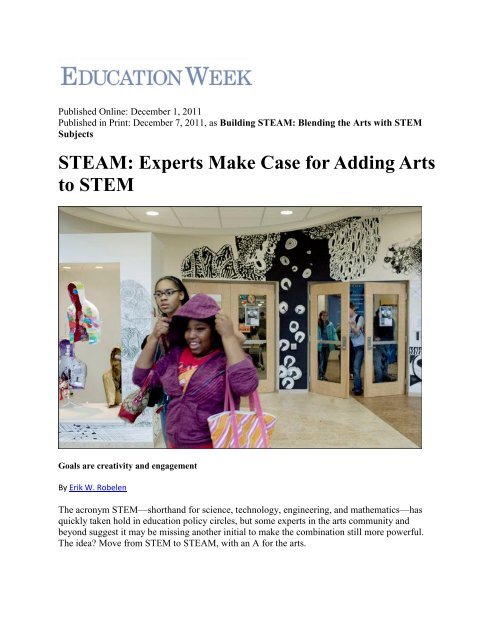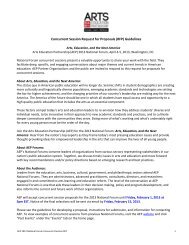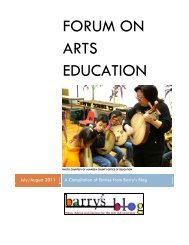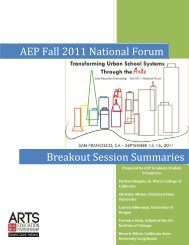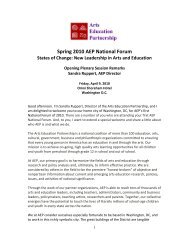STEAM: Experts Make Case for Adding Arts to STEM
STEAM: Experts Make Case for Adding Arts to STEM
STEAM: Experts Make Case for Adding Arts to STEM
Create successful ePaper yourself
Turn your PDF publications into a flip-book with our unique Google optimized e-Paper software.
Published Online: December 1, 2011<br />
Published in Print: December 7, 2011, as Building <strong>STEAM</strong>: Blending the <strong>Arts</strong> with <strong>STEM</strong><br />
Subjects<br />
<strong>STEAM</strong>: <strong>Experts</strong> <strong>Make</strong> <strong>Case</strong> <strong>for</strong> <strong>Adding</strong> <strong>Arts</strong><br />
<strong>to</strong> <strong>STEM</strong><br />
Goals are creativity and engagement<br />
By Erik W. Robelen<br />
The acronym <strong>STEM</strong>—shorthand <strong>for</strong> science, technology, engineering, and mathematics—has<br />
quickly taken hold in education policy circles, but some experts in the arts community and<br />
beyond suggest it may be missing another initial <strong>to</strong> make the combination still more powerful.<br />
The idea? Move from <strong>STEM</strong> <strong>to</strong> <strong>STEAM</strong>, with an A <strong>for</strong> the arts.
Although it seems a stretch <strong>to</strong> imagine <strong>STEM</strong> will be replaced in education parlance, momentum<br />
appears <strong>to</strong> be mounting <strong>to</strong> explore ways that the intersection of the arts with the <strong>STEM</strong> fields can<br />
enhance student engagement and learning, and even help unlock creative thinking and<br />
innovation.<br />
In fact, federal agencies, including the U.S. Department of Education and the National Science<br />
Foundation, are helping <strong>to</strong> fuel work in those areas.<br />
The NSF has provided research grants and underwritten a number of conferences and workshops<br />
around the nation this year, including a <strong>for</strong>um hosted by the prestigious Rhode Island School of<br />
Design, titled “Bridging <strong>STEM</strong> <strong>to</strong> <strong>STEAM</strong>: Developing New Frameworks <strong>for</strong> Art-Science-<br />
Design Pedagogy.”<br />
Picking up on the Rhode Island institution’s push <strong>for</strong> <strong>STEAM</strong>, in late September, a lawmaker<br />
from that state, U.S. Rep. James Langevin, a Democrat, introduced a House resolution <strong>to</strong><br />
highlight how “the innovative practices of art and design play an essential role in improving<br />
<strong>STEM</strong> education and advancing <strong>STEM</strong> research.”<br />
On-the-ground examples of bringing the arts and <strong>STEM</strong> learning <strong>to</strong>gether abound, from<br />
Philadelphia and San Diego <strong>to</strong> Day<strong>to</strong>n, Ohio.<br />
For instance, the Philadelphia <strong>Arts</strong> in Education Partnership, with support from a $1.1 million<br />
Education Department grant, is working with city schools <strong>to</strong> help elementary students better<br />
understand abstract concepts in science and mathematics, such as fractions and geometric shapes,<br />
through art-making projects.<br />
High school students in several U.S. cities, meanwhile, compete <strong>for</strong> an annual ArtScience Prize.<br />
First launched in Bos<strong>to</strong>n in 2008, the contest fuses concepts in the arts and design with the<br />
sciences. The theme of last school year’s curriculum and contest was the Future of Water. This<br />
year, it’s Virtual Worlds, and next, the emerging field of synthetic biology.<br />
One advocate of the <strong>STEM</strong> <strong>to</strong> <strong>STEAM</strong> push is Harvey Seifter, the direc<strong>to</strong>r of the Art of Science<br />
Learning, a project financed by an NSF grant that organized three conferences last spring in<br />
Washing<strong>to</strong>n, Chicago, and San Diego that brought <strong>to</strong>gether scientists, artists, and researchers, as<br />
well as educa<strong>to</strong>rs, business leaders, and policymakers <strong>to</strong> explore how the arts can be engaged <strong>to</strong><br />
strengthen <strong>STEM</strong> learning and skills and produce a more creative American work<strong>for</strong>ce.<br />
“For me, it is about connecting—or reconnecting—the arts and sciences in ways that learning<br />
can happen at the intersection of the two,” said Mr. Seifter, an expert in arts-based learning who<br />
also consults with Fortune 500 companies on fostering business creativity. “We believe there is a<br />
powerful opportunity here <strong>to</strong> use the arts and arts-based learning <strong>to</strong> spark trans<strong>for</strong>mational<br />
change in science education.”<br />
One core idea Mr. Seifter and other <strong>STEAM</strong> advocates emphasize is that the arts hold great<br />
potential <strong>to</strong> foster creativity and new ways of thinking that can help unleash <strong>STEM</strong> innovation.
“There is creativity in <strong>STEM</strong> itself, super genius in it, ... but in arts education, it really is the<br />
raison d’etre <strong>to</strong> be out of the box, <strong>to</strong> accept the chaos,” said John Maeda, the president of the<br />
Rhode Island School of Design, in Providence.<br />
Artists and designers, he said, are “risk takers, they can think around corners.”<br />
Mr. Maeda invokes <strong>STEAM</strong> as a pathway <strong>to</strong> enhance U.S. economic competitiveness, citing as<br />
an example the late Apple co-founder, Steve Jobs, a leading <strong>for</strong>ce behind the iPod, iPhone, and<br />
other electronic devices.<br />
“What <strong>STEAM</strong> means, it should feel like Steve Jobs, what he did <strong>for</strong> America,” Mr. Maeda said.<br />
“It is an innovation strategy <strong>for</strong> America.”<br />
In da Vinci’s Footsteps<br />
To be sure, the idea of integrating the arts with learning in other fields, including the stem<br />
disciplines, is not new. In fact, some observers have noted an increase of late in activity more<br />
broadly <strong>to</strong> promote arts integration across the curriculum, at a time when the arts struggle <strong>to</strong> keep<br />
a foothold in classrooms amid school budget cuts and the pressure <strong>for</strong> academic gains in core<br />
subjects like reading and math. ("Schools Integrate Dance In<strong>to</strong> Lessons," Nov. 17, 2010.)<br />
But some experts perceive a special connection between the arts and the <strong>STEM</strong> fields. Mr.<br />
Seifter, <strong>for</strong> instance, points <strong>to</strong> a 2008 study led by Robert Root-Bernstein of Michigan State<br />
University, which found that Nobel laureates in the sciences were 22 times more likely than<br />
scientists in general <strong>to</strong> be involved in the per<strong>for</strong>ming arts. Others note that Albert Einstein was<br />
an accomplished violinist. And then there’s the Renaissance figure who some view as the<br />
personification of <strong>STEAM</strong>: Leonardo da Vinci, the Italian painter and sculp<strong>to</strong>r who also made a<br />
name <strong>for</strong> himself as a scientist, engineer, and inven<strong>to</strong>r.<br />
Whether integrating the arts with <strong>STEM</strong> education enhances student learning is not exactly a<br />
settled matter, as even advocates like Mr. Seifter are quick <strong>to</strong> acknowledge.<br />
“There is no question, <strong>to</strong> me, the critical missing piece is the data,” said Mr. Seifter. He adds that<br />
even as he’s witnessed the power of the intersection, he sees a critical need <strong>for</strong> a “solid body of<br />
empirical knowledge about what the arts bring <strong>to</strong> the <strong>STEM</strong> equation.”<br />
Indeed, research examining the effect of arts integration on student achievement across academic<br />
disciplines appears <strong>to</strong> show mixed results.<br />
Leaving the research question aside, however, some experts s<strong>to</strong>p short of embracing a change<br />
from <strong>STEM</strong> <strong>to</strong> <strong>STEAM</strong>.<br />
Alan J. Friedman, a <strong>for</strong>mer head of the New York Hall of Science, said it’s crucial <strong>for</strong> students<br />
not <strong>to</strong> lose sight of the differences, <strong>for</strong> example, between art and science.
“One crucial point at which they part ways is the act of deciding, ‘Is it good art? Is it good<br />
science?’ ” said Mr. Friedman, a member of the National Assessment Governing Board who<br />
holds a doc<strong>to</strong>rate in physics. “Science and art have a lot <strong>to</strong> learn from each other, a lot of<br />
inspiration <strong>to</strong> share, a lot of commonality. They also have some very essential differences that<br />
are at the core of what they are, which is why I have trouble with <strong>STEAM</strong>.”<br />
Susan R. Singer, a biology professor at Carle<strong>to</strong>n College in Northfield, Minn., echoes the point.<br />
“Not <strong>to</strong> devalue the symmetry, but they are very different ways of knowing the world,” said Ms.<br />
Singer, who previously served on the National Research Council’s Board on Science Education.<br />
“I would s<strong>to</strong>p short of <strong>STEAM</strong>, but celebrate the ways that they work <strong>to</strong>gether.”<br />
‘Fraction Mural’<br />
What the intersection of the arts with <strong>STEM</strong> learning looks like in practice varies widely.<br />
The Philadelphia <strong>Arts</strong> in Education Partnership is focused on math and science instruction in the<br />
elementary grades, with support coming from its four-year grant from the Education<br />
Department’s <strong>Arts</strong> in Education Model Development and Dissemination program. For example,<br />
through art-making projects, students at one school manipulated the abstract concepts underlying<br />
fractions <strong>for</strong> a more concrete understanding of how they work. The students even created a<br />
“fraction mural” displayed at the school.<br />
“We match arts skills and processes <strong>to</strong> a specific learning goal in math and science,” said Raye<br />
Cohen, the education direc<strong>to</strong>r at the Philadelphia arts group.<br />
She said that work with the visual arts is especially promising. “Visual arts just seems <strong>to</strong> really<br />
be able <strong>to</strong> home in on the concept, taking it from the abstract <strong>to</strong> the concrete, so students are<br />
really able <strong>to</strong> understand it,” she said.<br />
Ms. Cohen says the project involves an “intense research component” and will look at a variety<br />
of effects, including student test scores and suspensions and unexcused absences, as well as<br />
parent engagement in homework and changes in teaching practices.<br />
In Cali<strong>for</strong>nia, a $1.1 million grant last year by Cali<strong>for</strong>nia’s Postsecondary Education<br />
Commission, using federal teacher-quality aid, is supporting the 134,000-student San Diego<br />
school district’s work linking arts learning with science in grades 3-5.<br />
“It’s not just teaching science through the arts, but teaching science and the art <strong>to</strong>gether, and<br />
what comes from that is more than either of them standing alone,” said Karen Childress-Evans,<br />
the district’s direc<strong>to</strong>r of visual and per<strong>for</strong>ming arts.<br />
The Wolf Trap Foundation <strong>for</strong> the Per<strong>for</strong>ming <strong>Arts</strong>, based in Vienna, Va., has recently developed<br />
early-childhood initiatives that blend <strong>STEM</strong> learning with the arts. The work—supported in one<br />
instance by a 2010 federal Education Department grant, in another by the philanthropic arm of
aerospace giant Northrop Grumman—involves per<strong>for</strong>ming artists in theater, music, dance, and<br />
puppetry working alongside classroom teachers in preschool and kindergarten settings.<br />
The ArtScience Prize, working primarily with high school students, is built around the ideas of<br />
Harvard University professor David A. Edwards, the author of ArtScience: Creativity in the<br />
Post-Google Generation. Students typically work in small teams on projects across a year’s time<br />
in an after-school or in-school setting. The program has quickly expanded beyond Bos<strong>to</strong>n <strong>to</strong><br />
include Minneapolis and Oklahoma City, as well as international locations.<br />
The winning team in Oklahoma City earlier this year developed a biodegradable water bottle,<br />
while the <strong>to</strong>p-rated Bos<strong>to</strong>n team is creating public art installations that communicate how people<br />
around the world struggle <strong>to</strong> gain access <strong>to</strong> fresh water.<br />
“We’re empowering young people <strong>to</strong> come up with their own ideas while exploring and playing<br />
in the arts and science,” said Carrie Fitzsimmons, the executive direc<strong>to</strong>r of ArtScience Labs, the<br />
Cambridge, Mass.-based organization that manages the ArtScience Prize. “It’s all fun,<br />
experiential learning, but we’re teaching them <strong>to</strong> be critical thinkers and problem-solvers.”<br />
Meanwhile, a Georgia charter school with a self-described <strong>STEAM</strong> focus won a $1 million state<br />
grant this summer. The grant, part of the state’s Race <strong>to</strong> the Top award, will further the school’s<br />
work in connecting the disciplines through professional development and provide outreach so the<br />
campus can serve as a demonstration site.<br />
“We want <strong>to</strong> make <strong>STEAM</strong> a model <strong>for</strong> other schools ... all around our state,” Gov. Nathan Deal,<br />
a Republican, said in announcing the grant, according <strong>to</strong> the Atlanta Journal-Constitution.<br />
In Ohio, the Day<strong>to</strong>n Regional <strong>STEM</strong> School takes the integration of subjects, including the arts,<br />
seriously.<br />
Art teacher Jenny Montgomery said her colleagues in other disciplines often approach her about working<br />
<strong>to</strong>gether. Last month, <strong>for</strong> instance, she team-taught with a biology teacher as part of a project in which<br />
students made watercolor paintings of cells.<br />
“We were studying cell structure,” she said, “and we were looking at paintings [the students<br />
created] ..., these beautiful artistic renderings, and students could pick out the structures that they<br />
had been studying.”<br />
Ms. Montgomery said her work with science teachers has helped her make connections between<br />
the disciplines.<br />
“One thing we looked at ... was how artists and scientists have common methodologies in<br />
observing the world around them,” she said.<br />
At the same time, Ms. Montgomery said, even in a <strong>STEM</strong> school, it’s important <strong>for</strong> art not<br />
simply <strong>to</strong> be valued <strong>for</strong> its application <strong>to</strong> other disciplines.
“I also uphold the value of making art <strong>for</strong> art’s sake,” she said, “that students have an<br />
opportunity just <strong>to</strong> engage in art <strong>for</strong> the sheer joy of it.”<br />
Coverage of leadership, expanded learning time, and arts education is supported in part by a<br />
grant from The Wallace Foundation, at www.wallacefoundation.org.<br />
Web Only


